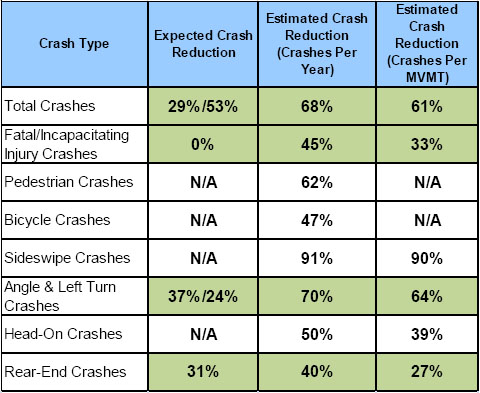A biweekly newsletter with public space news, resources, and opportunities.
A curated dispatch on all things public markets plus the latest announcements from the Market Cities Program.
Tampa, FL
4 Lane → 3 Lane Conversion + Bike Lanes

Nebraska Avenue is an urban commercial and residential arterial street that was reconstructed between 2007 and 2008 to improve safety for all users. The street was previously a dangerous corridor for pedestrians, bicyclists, and motorists with a relatively high motorized vehicle crash rate. The Florida Department of Transportation (FDOT) redesigned 3.2 miles of Nebraska Avenue to make it more efficient for buses, better suited for people with disabilities, and safer for drivers, pedestrians, and cyclists, all with great success. The rightsizing was accomplished by converting one lane to bike lanes, transforming a travel lane into a combination of medians and left-hand turn bays, and upgrading other infrastructure.


*Average annual before data was taken from 2004 to 2006 statistics, and after data drew from 2009 to 2011 statistics.The before and after report below notes that crashes may have declined further than the statistics above indicate because of aberrant reporting in one year of the after period.
The rich text element allows you to create and format headings, paragraphs, blockquotes, images, and video all in one place instead of having to add and format them individually. Just double-click and easily create content.
The rich text element allows you to create and format headings, paragraphs, blockquotes, images, and video all in one place instead of having to add and format them individually. Just double-click and easily create content.
Body Text Body Link
The rich text element allows you to create and format headings, paragraphs, blockquotes, images, and video all in one place instead of having to add and format them individually. Just double-click and easily create content.
Here is some highlighted text from the article.




Headings, paragraphs, blockquotes, figures, images, and figure captions can all be styled after a class is added to the rich text element using the "When inside of" nested selector system.
Headings, paragraphs, blockquotes, figures, images, and figure captions can all be styled after a class is added to the rich text element using the "When inside of" nested selector system.
Headings, paragraphs, blockquotes, figures, images, and figure captions can all be styled after a class is added to the rich text element using the "When inside of" nested selector system.

We are committed to access to quality content that advances the placemaking cause—and your support makes that possible. If this article informed, inspired, or helped you, please consider making a quick donation. Every contribution helps!
Project for Public Spaces is a 501(c)(3) tax-exempt organization and your donation is tax-deductible within the guidelines of U.S. law.